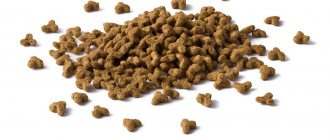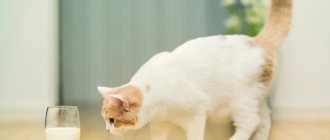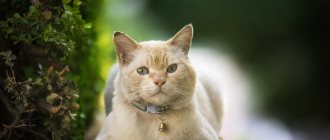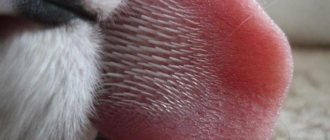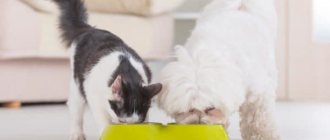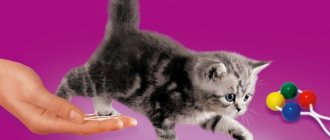The reason that a cat does not have milk can be a difficult birth, exhaustion, stress and other factors. In this case, you can save offspring only if you start feeding the kittens yourself. It is also worth trying to restore lactation if this does not pose a threat to the health of the mother and babies.
Let's find out what to do if a cat doesn't have milk after giving birth, and what measures need to be taken urgently to save the kittens.
When does a cat produce milk?
2-5 days before giving birth, the cat may begin to secrete colostrum from her nipples. It is a slightly yellowish liquid containing a large amount of specific proteins. The most significant proteins for kittens are immunoglobulin proteins, which are produced in the mother’s body, enter the mammary glands and are excreted in milk and colostrum.
During feeding, immunoglobulins pass unchanged through the baby’s stomach and are then absorbed into the blood. It is the content of these substances that determines the formation of passive immunity to viruses and bacteria in kittens in the first days of life.
2-3 days after birth and the start of lactation, colostrum is gradually replaced by milk. According to recent research by scientists, it was found that colostrum and milk in cats contain approximately the same amount of immunoglobulins. Also, this indicator persists for two weeks after birth, while in other mammals it constantly decreases.
Important! Breeders of British Shorthair cats and Devon Rex cats sometimes face the problem of neonatal isoerythrolysis, in which a kitten with a certain blood type experiences an incompatibility reaction with mother's milk. In this case, the cat's antibodies, entering the baby's body, cause hemolysis of red blood cells. If this pathology is not recognized in time and the kittens are not transferred to artificial feeding, then death becomes inevitable. This phenomenon practically does not occur in representatives of other breeds.
In some cats, colostrum appears only a day after birth under the influence of the kittens' sucking movements. The timing of when a cat produces milk depends on the individual characteristics of the body, conditions of detention and the complexity of childbirth.
Normal pregnancy process, stages and timing
In a healthy animal, the process of pregnancy and childbirth occurs without the need for intervention or assistance. In purebred, small, problem cats, childbirth may occur with complications. In more developed countries, there is a special profession - zooobstetrician, a specialist responsible for the favorable course of childbirth, preserving the life and health of the mother and offspring. In “our realities,” all responsibility falls on the shoulders of the owners and general veterinarians.
On average, a normal cat pregnancy lasts 60–65 days, but the period can vary by 7–10 days depending on the breed and body composition of the expectant mother. Conventionally, pregnancy is divided into 3 stages:
- Mating – 3 weeks: after mating, the cat experiences swelling of the mucous membranes of the genital tract, but this does not guarantee pregnancy. Clear signs are observed from the third week: Drowsiness, decreased appetite and activity.
- Requires affection and attention.
- Vomiting (no more than 3 times a day, no longer than 2-3 days).
- Distinct pigmentation of the mammary glands - from light to bright pink.
- An enlarged uterus, which can be detected by a veterinarian by palpation.
- 4-6 weeks: Rapid growth of the “babies” and “rounding” of the cat. By week 6, the amount of fluid in the uterus increases, and the kittens begin to make their first movements.
- Kittens can be “felt” when gently palpated.
- The cat eats and sleeps more, otherwise behaves as usual.
- 7–9 weeks: Kittens are actively moving. The movements are clearly visible to the naked eye, especially if the cat is sleeping.
- Swelling of the mammary glands, release of colostrum.
- Some cats have a whitish vaginal discharge, which is normal.
- Increased anxiety and making a “den”.
Important! “Nesting” is not observed in all animals. A cat with increased social activity will benefit from the foresight of the owners in arranging the place and assisting in childbirth. “Tethered cats” need to be monitored especially carefully; hormones and a “naughty” character can lead the animal to a “breakdown” and rash actions, which can lead to premature birth or abandonment of kittens.
Causes of lactation disorders
The reasons why cats do not produce milk can be pathological and physiological factors.
- A difficult birth, during which the cat loses a lot of blood, can cause a lack of milk in the first day. Good care, complete rest and good nutrition will quickly restore her strength, and milk will gradually appear. If metritis, eclampsia develops after birth, bleeding, prolapse or subinvolution of the uterus is observed, then the kittens should be transferred to artificial feeding, and the cat should urgently call a veterinarian at home. Transporting an animal in this condition can be fatal.
- Stress. Many cats try to retire in order to give birth to their offspring in a safe place. But some pets prefer to give birth in the presence of their owner, as they experience a certain fear of childbirth and trust the person. And at this moment, many owners make the grave mistake of inviting their children, other family members or friends to see their newborn babies. For a cat, this is extremely stressful and a kind of betrayal, since strangers always pose a potential threat to the cubs. In this condition, the cat may lose milk, and in the worst case, she will abandon the kittens.
- Mastitis. Severe pain during inflammation of one or more mammary glands leads to the fact that the cat stops feeding the kittens and her milk gradually disappears.
- Exhaustion. An insufficient amount of fat in a cat’s body leads to serious hormonal imbalances, as a result of which the female does not begin to lactate.
- Cannibalism. This phenomenon refers to genetic abnormalities. Scientists have put forward several versions to explain females eating their own offspring. However, the exact reason has not yet been established. If a cat exhibits cannibalism towards its own kittens, then it is removed from breeding, since a similar phenomenon will be repeated after the birth of subsequent offspring.
- Premature heat often causes a cat to lose milk. A feature of the reproductive and hormonal system of cats is the ability to fertilize a few days after birth. Signs of heat may appear in a female immediately after the birth of her offspring if there is a male nearby. Therefore, owners of pets of different sexes should take care of their isolation in advance.
A few days before the expected birth, you should set up a place where the cat can feel comfortable. This can be a spacious basket, box or makeshift playpen, which should be placed in a warm, dry place.
This room should be free from drafts, loud noises and bright lights, but the cat should have access to clean water and a toilet at all times.
Important! At the first symptoms of an infectious disease in a cat during lactation, you should immediately wean the kittens and contact a veterinarian. After assessing the condition of the animal, he will decide on the possibility of further feeding the offspring by the female.
Harbingers of childbirth
Harbingers are considered to be changes in the animal’s vital activity within 24 hours before birth. The cat's uterus is arranged in the shape of the letter “Y” - the “horns” are the place of the kittens, the “tail” is the cervix. The main changes occur precisely in it, accompanied by discomfort or pain. Miscarriage and spontaneous childbirth are accompanied by the same symptoms, with one difference. Signs of premature birth in a cat most often occur 1-2 times faster.
This is interesting: Tick-Borne Encephalitis Symptoms in Dogs
As soon as you notice your cat's anxiety, pay attention to the following aspects:
- Most often, before the onset of contractions, a mucus plug comes out of the cervix - a small clot of a transparent, yellowish, greenish color, small brown inclusions are considered normal. You need to understand that the cork’s rejection may not be noticed. It can come out during urination or be torn off in parts - the cat licks itself, the discharge is unnoticeable.
- During pregnancy, kittens lie according to the “compact” principle, and for proper birth they need to turn around with their heads down. Large “babies” may not have time to do this, but during the process there is active movement of the fetuses - the kittens turn and push, causing a lot of inconvenience to the mother.
- The first contractions are barely noticeable, but can be felt if you put your palm on the cat’s stomach - the opening of the cervix begins, the process can take up to 8 hours.
Preparedness #1! Signs of an imminent birth in a cat are strong contractions, noticeable without palpation, the cat lies on its side or squats and arches its back - in the period from 5 to 60 minutes the first “baby” will appear.
How to tell if kittens don't have enough milk
The main criterion for a kitten to be full is sleep. In the first month of life, the baby wakes up only to satisfy the feeling of hunger. Therefore, well-fed kittens sleep most of the day, while hungry kittens scream, crawl away, or tug at their mother’s nipples for a very long time and intensively.
A kitten's satiety can also be judged by its body weight gain. On average, a healthy baby should gain at least 7-10 grams per day. If this indicator is significantly reduced, then you should consult a veterinarian or an experienced breeder about the possibility of complementary feeding.
Important! With mastitis, pathogenic microorganisms develop in the cat's milk, which enter the kitten's body and cause severe gastrointestinal disorders, which can be fatal. Therefore, it is necessary to isolate kittens from sick kittens and transfer them to artificial feeding.
Pedigree feed lines
If you have a purebred pet, it is better to choose food based on its characteristics. There are a huge number of brands that produce specialized food for a specific breed. Specialists take these breeds into account in advance and prepare the right diet for your pet.
During the lactation period, you should not skimp on your pet’s nutrition, because if you pay due attention to this point, you will save yourself from a number of problems. Experienced breeders prefer several types: Hills, Royal Canin Queen or Royal Canin.
These are the most optimal and high-quality brands that really produce good food. In the price category they are higher than Whiskas, Oscar and so on. But the quality and composition speaks for itself.
Why you should choose these brands:
The rulers are specially developed taking into account the characteristics of the pet’s breed and life period.
All components that the food contains primarily have an anti-inflammatory effect. They improve intestinal microflora and restore immunity after pregnancy.
The food consists of 1/3 protein and contains all the necessary vitamins and minerals. They do not add impurities that cause the cat to go crazy and start overeating. Has no pungent odor or dye.
Picture: What can and cannot be given to a cat during pregnancy
Stimulation of lactation
If all signs indicate that the kittens have enough milk, then the cat should not be given additional medical or homeopathic medications, or use folk remedies. Excess milk can cause mastitis.
An optimal level of lactation should be maintained through proper nutrition, hydration and minimizing stress.
The basis of a cat's diet during breastfeeding should be ready-made wet food for lactating females. The composition of such mixtures usually includes the necessary complex of vitamins and minerals.
If the cat is on a natural diet, then its diet should include:
- lean meats;
- oatmeal, buckwheat and rice porridge;
- dairy products;
- quail eggs;
- boiled vegetables (carrots, zucchini, pumpkin);
- fish fat;
- milk 2.5% (with good tolerance of natural milk to animals).
On the recommendation of a veterinarian, you can additionally give vitamin-mineral complexes or calcium supplements.
In case of a lack of milk, there are several methods for stimulating lactation in cats:
- Within 5 days after birth, administer 0.2 ml of oxytocin subcutaneously once a day.
- Intravenous or subcutaneous injections of Ringer's solution with 5% glucose solution and sodium chloride.
- If a decrease in the amount of milk is provoked by stress factors, then use a Fospasim solution, which is administered subcutaneously once a day at a dose of 1 ml per animal.
Important! Some breeders recommend feeding cats Apilak tablets, which, when dissolved, increase lactation in women. However, their effectiveness for cats is questionable due to the inability to ensure the absorption of the drug by the animal. You should also consider the possibility of allergic reactions to bee products.
There are several folk recipes for enhancing lactation in cats.
Recipe No. 1
Ingredients for 1 dose:
- 2 liters of boiled milk with 2.5% fat content;
- 3 pcs. raw quail eggs;
- 5 ml of 40% glucose solution;
- 1 tablet of brewer's yeast.
Mix all the ingredients and drink it to the cat 3-4 times a day.
Recipe No. 2
Dry nettle inflorescences, crushed to a powder consistency, add 0.5 tsp. in every serving of food.
Recipe No. 3
Ingredients:
- carrots - 1 pc.;
- milk 2.5% - 0.5 l;
- natural sour cream - 2 tbsp. l.
Preparation:
- pour boiling milk over grated carrots;
- wrap and leave for 1-2 hours;
- cool to +40 °C;
- strain;
- add sour cream;
- stir;
- leave in a warm place until completely soured.
Divide into equal portions and give to the cat throughout the day.
There are many more recipes based on decoctions and infusions of herbs. The disadvantage is the forced infusion, which creates additional stress for the cat. Therefore, the appropriateness of their use remains controversial.
Cat milk replacers and kitten formulas
Many cat owners believe that small kittens can only be fed with cow's milk, but this opinion is wrong. This product will cause babies to have diarrhea and they will not grow well. Special milk substitutes and formulas should be chosen as the main diet for newborn kittens.
The following industrial cat milk replacers are commercially available:
- Beaphar Kitty Milk. The product is manufactured in the Netherlands. The dry powder is diluted in warm water in the following proportion: 7 grams of mixture per 50 grams of liquid. The resulting product can be stored in the refrigerator for 8 hours. Before the next feeding, it is heated to 40 degrees. The average cost of a milk substitute is 800-1200 rubles. per jar 200 gr.
- Gimpet Cat-Milk with added taurine. The manufacturer of this product is Germany. The compositions of the Gimpet substitute and cat milk are almost identical. The powder is dissolved in hot water in the ratio: 1 tbsp. mixture to 3 tbsp. liquids. The average price of a 200 g jar is 700-900 rubles.
- Royal Canin Babycat Milk. This product is made in France. 10 grams of powder are dissolved in 20 ml of warm water. The resulting mixture must be fed to the babies within 60 minutes. The price of a package weighing 300 grams varies from 900 to 1300 rubles.
Baby formula
It is permissible to use infant formula for kittens only if it is not possible to purchase a complete cat's milk substitute. When choosing, carefully study the composition of the product: it should contain no sugar.
IMPORTANT! You should choose formulas intended for feeding children from birth, and not from 2-3 months. Various fruit, honey and other additives that may be included in the composition are prohibited for kittens.
To feed small pets, baby formula is diluted in warm water, but the recommended amount of liquid is doubled. The diluted milk is stored in the refrigerator for 24 hours. Before the next meal, the required amount of the mixture is heated and given to the babies.
Scott's Kitten Mix
If you can’t buy a ready-made milk replacer, you can make Scott’s formula for kittens using this recipe:
- Whole cow's milk – 50 g.
- Whole milk powder – 15 g.
- Chicken egg – 1 pc.
- Whipped chicken egg white – 1 pc.
- Dry yeast – 2.5 g.
- Glucose – 4 g.
- Vegetable oil – 1 gr.
This mixture is fed to babies in the amount of 23-25 grams per day. It is preheated to a temperature of 40 degrees.
Tailing mix for kittens
Tiling mixture for kittens is prepared from the following ingredients:
- Whole milk (both cow and goat milk are suitable) – 25 g.
- Whole milk powder – 5 g.
- Glucose solution – 2 g.
- Crushed vitamins for kittens – 1g.
The mixture components are mixed well. All dry ingredients should dissolve in the milk. Before feeding, the liquid gruel is heated to 40 degrees. This mixture is given to kittens, following general recommendations.
Feeding newborn kittens
If a mother cat has lost her milk and the owner does not know what to feed the kittens, then the ideal option would be to find another cat who can provide them with food. However, such a coincidence of circumstances is quite rare. And if the cat does not have milk, then the owner has no choice but to take care of all the newborn babies.
To feed newborn kittens, you should use a syringe without a needle, a pipette or a small pacifier. To make the process safe and more convenient, you should adhere to the following algorithm of actions:
- open the kitten's mouth slightly;
- place the tip of the syringe behind the cheek on the side;
- squeeze out 1-2 ml of the mixture;
- wait for the baby to swallow;
- continue feeding.
To avoid food getting into the respiratory tract, the kitten's head should not be thrown back while feeding.
From three weeks of age, you can introduce beef or chicken puree, low-fat cottage cheese diluted with milk or kefir, egg yolk or quail eggs into your baby’s diet.
What signs predict an imminent birth?
Since pregnancy in cats is quite fleeting, it is important to know the signs of labor so as not to miss the time of birth of a new life. The first symptoms begin and fade a couple of weeks before the crucial moment arrives. The offspring in the womb begins vigorous activity, and the cat itself scours the apartment in search of a secluded place. In turn, a few hours before the birth of kittens, the animal’s habits change dramatically :
- the cat becomes worried and begins to rush around the apartment, licking its tummy and genitals;
- at the moment when contractions appear, the pet begins to breathe quickly and heavily;
- rectal temperature readings drop below 37 ºC, which is normal;
- there is swelling of the genital organs, accompanied by discharge;
- Colostrum is released through the swollen mammary glands.
This is interesting: Droplets of Blood in a Cat After the Birth of Kittens
Almost all cats, before giving birth, meow loudly and hide in a secluded place where no one will disturb them.
Feeding schedule
The frequency of feedings and the volume of servings of formula depend on the age and body weight of the kittens.
| Days | Amount of mixture (ml/100g) | Number of feedings per day |
| From 1 to 4 days | 30 | 12 |
| From 5 to 13 days | 38 | 10 |
| From 14 to 24 days | 46 | 8 |
| From 25 to 35 days | 53 | 6 |
Feeding kittens takes place in 2 stages. At the first stage, the baby intensively sucks the mixture, after which he goes to the toilet. Then he continues to eat food, but with less greed and gradually falls asleep. At this point, the feeding process can be considered complete.
Healthy food rules
The rules during lactation and pregnancy are almost similar. There are only small nuances that require your attention. Nutrition during breastfeeding has three basic rules:
- After giving birth, she must replenish her strength;
- The required amount of milk must be produced independently;
- High energy costs must be supplemented with high-quality nutrition.
Nutrition should not only ensure the healthy functioning of your pet during feeding, but also allow her to maintain strength for future offspring.
The amount and frequency of feeding depends on three components:
- Litter;
- Animal weight;
- Age.
Attention! After pregnancy, a pet needs approximately twice as much food as before.
Don't worry if your ward refuses to eat after pregnancy. Her taste preferences have probably changed. Many coated cats refuse to eat food and prefer natural products.
The owner should be careful about such changes and try not to spoil the cat with products that are new to it. Before switching your pet from one type of food to another, you should contact an experienced veterinarian for a recommendation.
Often cats can suffer from allergies, which also affects the milk and health of the growing generation.
If the animal still refuses to eat food, demanding fish and meat, gradually switch it to natural food . Make sure that the animal continuously receives the required amount of beneficial microelements that are needed for healthy feeding.
It is worth noting that magnesium and calcium deficiency primarily affects the coat and teeth. If you notice that your pet is shedding a lot and the teeth have acquired an unusual plaque, the cat is probably not receiving the required amount of vitamins.
The owner should ensure that the cat regains its weight immediately after the kittens are able to move independently. Ideally, well-fed offspring should be next to the mother.
How to help a kitten go to the toilet
In the first three weeks of life, independent defecation is difficult in kittens, so the cat stimulates it by intensely pressing the tongue on the abdomen and genitals.
In order to reproduce the actions of a mother cat, you should take a cotton or cloth swab moistened with warm water and lightly massage the baby's tummy after each feeding.
Important! After each act of defecation and urination, the kitten must be wiped with a damp cotton pad. If this is not done, he will develop severe dermatitis.
Cat's milk is a valuable product for kittens, which contains not only all the necessary nutritional components, but also immunity factors to most infectious diseases. Without receiving antibodies from their mother, babies from the first days become helpless in the face of pathogenic agents that can lead to their death.
The need to feed newborn kittens in the absence of milk from the cat requires knowledge, skills, patience and certain material costs from the owners.
The situation can also be complicated by illness or death of the mother cat. Therefore, it is necessary to learn in advance how to act in such cases in order to make the task at least a little easier for yourself and at the same time preserve the life of the babies and the health of the female.
General rules and recommendations for hosts
First of all, you need to make sure that all kittens receive food on time. To do this, the owner independently places them next to the mother every two hours.
Of course, in most cases the furry mother does this on her own, but unforeseen situations happen when she refuses to do this.
Together with mother's milk, kittens receive all the necessary vitamins and microelements to strengthen their body. In turn, during pregnancy, the ward may begin to lose her beauty and get sick.
To prevent the nurse from experiencing anxiety and discomfort, you need to monitor her nutrition. Cat food must be appropriate for the breed and selected specifically for nursing mothers. Such food already contains all the necessary beneficial elements that a cat needs during milk production.
In order to choose the right nutrition, pay attention to the composition of the food; it must be rich in: calcium, minerals and trace elements.
Important! It is worth considering that she will feed the kittens for up to two months. Energy consumption will increase several times.
In order not to overdo it with nutrition or to avoid underfeeding , the owners need to create a small schedule according to which the nursing mother will eat. She, like kittens, should be fed small portions every few hours.
The nurse should not overeat and feel hungry; it is also necessary to monitor water consumption. A healthy mother who is nursing kittens consumes more than 250 ml of water per day. By observing this norm, she will not suffer from dehydration.
The food of a nursing mother should not only be varied, but also contain all the necessary substances.
Is it possible to speed up the appearance of milk?
Young mothers are wondering what needs to be done to ensure milk comes in as quickly as possible? Breastfeeding experts offer the following advice on this matter:
- Since the hormones prolactin and oxytocin, which are intensively produced when the baby sucks on the mother’s breast, are responsible for the process of producing breast milk by the female body, then to speed up the flow of milk and increase its quantity, you need to feed the baby as often as possible.
- Due to the fact that prolactin is most actively produced at night, a new mother needs to put her baby to her breast several times throughout the night.
- It is advisable to alternately place the baby on one breast and the other at each feeding. Moreover, the order of application must be constantly alternated so that the mammary glands are developed evenly.
- On the third day after birth, it is advisable to slightly reduce fluid intake. During this period, milk intensively flows into the glands, so excess fluid can lead to painful sensations and swelling of the breasts.
A cat gives birth: only calm
One of the most significant and exciting events for a caring owner is the birth of a cat. Especially if this event happens for the first time. During the birth process, the cat may need help, so it is better to prepare for it in advance.
How to determine that labor is coming soon?
Pregnancy and birth of a cat go quite quickly. In order not to miss an important moment, you need to carefully observe the behavior of your pet. Precursors of childbirth appear approximately two weeks before the event itself. The kittens in the mother’s belly are actively moving (no matter how many there are), and the cat begins to look for a secluded place. Immediately before giving birth, the animal’s behavior becomes even more characteristic:
Most cats of different breeds (for example, British) meow loudly in pain and try to hide. But it happens that even during contractions, right before the kitten comes out, the woman in labor is cheerful and playful.
What should the owner do?
When the harbingers of childbirth become obvious, it is necessary to prepare a nest in which the kittens and cat will live after birth. The main requirement for a house is privacy and protection from drafts. The nest should be closed from prying eyes. For this purpose, you can use a box or special cat houses. The entrance is made in the form of a small hole located at the level of the animal’s chest.
Before giving birth, you should also think about bedding. The bottom of the nest can be covered with a disposable diaper or soft paper (as needed). This first bedding will then have to be thrown away, so expensive materials are not needed here.
During contractions, animals behave differently. For example, most Scottish purrs are characterized by throwing. The animal can climb into the closet, under the bed, into the nightstand. In this case, you need to calm the expectant mother, move her to a prepared house and sit next to him while he
Source
ALL ABOUT CAT LIFE Our site is dedicated to all cat lovers. You will learn a lot of new information about the characters and habits of your favorite pets
All cats are very different. Big and small, warlike and cute, but they are all beautiful in their own way. Find out about the most famous breeds on our website
They can be serious and important, and they can be funny and funny. Find out how your pets can make you happy and laugh
What to do?
To find out why a new mother does not have milk, you should take her to a veterinarian to rule out diseases and serious pathologies. But the first thing you need to do is take care of the kittens. After all, they cannot wait long.
There are special mixtures for feeding small kittens; they can be purchased at any pet store. If it is not possible to buy such food, cow's milk is also suitable, but it is advisable to mix it with chicken yolk and a small amount of vitamins for kittens. Kittens should be fed through a bottle with a small nipple.
In order for your cat to produce milk, she needs to be given a good drink of water immediately after giving birth. Cream, cottage cheese, kefir, and chicken yolks are included in the diet.
If your pet ate dry food before giving birth, it should be switched to soft food for a while.
Pet stores sell special food for nursing cats; it contains everything necessary to stimulate lactation. It is recommended to make mixtures of glucose, yolk and cream; such a delicacy will increase milk flow.
When the veterinarian, during examination, does not find any obvious reasons for the lack of milk, he may prescribe sedatives to the cat to relieve stress from the animal or injections that stimulate lactation.
What not to feed a cat during lactation and pregnancy
List of 7 products that are strictly prohibited:
- Raw fish from rivers and reservoirs. Often such fish contain a large number of parasites, which can lead to the death of the pet.
- Raw meat - cats do not digest its consumption well if they live outside their will.
- Pork is high in fat and allergenic. Pork causes allergies in many animals.
- Salty, spicy, sweet - destroys the digestive system.
- Potatoes – cats have an intolerance to starch consumption.
- Bones are dangerous and can cause your pet to choke.
- Flour is complex carbohydrates that do not provide any benefit.
Diet. While your cat is nursing kittens, she needs to be fed 5-6 times a day. The cat will let you know when it is hungry.
The owner only needs to replenish the bowl on time and provide access to fresh water.

